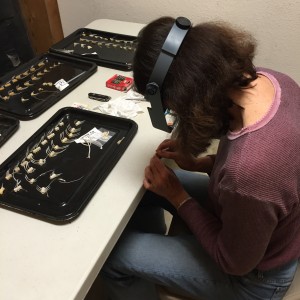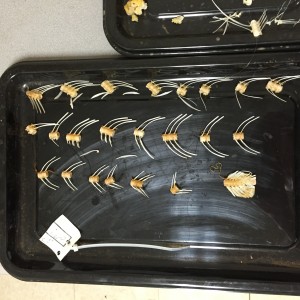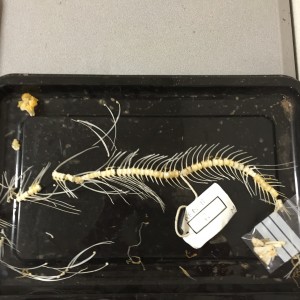 Since we stopped excavating on Thursday, August 13, I have spent much of my time over the last 2 days sewing half-macerated salmon spines. During our time here at Nunalleq (see Nunalleq.wordpress.com), my University of Aberdeen colleague Edouard Masson-Maclean has been building a large collection of salmon carcasses representing various species of Oncorhynchus and Salvelinus so as to try to see if he can develop a new geometric-morphometric method that can be used to distinguish salmon species. Some readers will recall our optimism with the Huber et al. (2011) method, but our findings in Moss, Judd, and Kemp (2014) raised some questions about the accuracy of the method. You will have to watch for Edouard’s blog entry (hopefully coming soon) on the Nunalleq blog to find out more about the method.
Since we stopped excavating on Thursday, August 13, I have spent much of my time over the last 2 days sewing half-macerated salmon spines. During our time here at Nunalleq (see Nunalleq.wordpress.com), my University of Aberdeen colleague Edouard Masson-Maclean has been building a large collection of salmon carcasses representing various species of Oncorhynchus and Salvelinus so as to try to see if he can develop a new geometric-morphometric method that can be used to distinguish salmon species. Some readers will recall our optimism with the Huber et al. (2011) method, but our findings in Moss, Judd, and Kemp (2014) raised some questions about the accuracy of the method. You will have to watch for Edouard’s blog entry (hopefully coming soon) on the Nunalleq blog to find out more about the method.
In the meantime, Edouard has collected ~20 individuals each of king, silver, red, and pink salmon and Dolly Varden and rainbow trout. That’s alot of fish! The method involves working with the vertebrae, the most common element found archaeologically. Edouard wants to track the measurements of each vertebra (by number) so the individual vertebrae must be preserved in anatomical order— and salmon have more than 60 vertebrae each! So when the spines are partly macerated, but still articulated, you pull the spinal column out of the bucket in which it is soaking, and disarticulate the vertebrae in order (as shown in the photo below)
 and then sew them together. I’ve been starting from the tail, and using a steel sewing needle. It’s a bit messy (and smelly) because there’s still cartilage between the vertebrae and the notocord itself is amazingly strong… I often have to dig it out with my needle. I haven’t hand-sewn anything for multiple hours for many years… it is tiring work for the fingers.
and then sew them together. I’ve been starting from the tail, and using a steel sewing needle. It’s a bit messy (and smelly) because there’s still cartilage between the vertebrae and the notocord itself is amazingly strong… I often have to dig it out with my needle. I haven’t hand-sewn anything for multiple hours for many years… it is tiring work for the fingers.
Intensive sewing like this gives me a new found appreciation for the seamstresses and skin-boat sewers at Nunalleq… they spent many hours sewing caribou hide, walrus and sealskins, birdskins, etc. Their stitches had to be perfect to sew waterproof clothing and the skins covering the kayaks and umiaqs. What a job! I didn’t have a thimble, but was able to use the corner of the table as an anvil of sorts to press my needle through. I also relied alot on my teeth to pull the needle through, as seamstresses have been doing for thousands, or even tens of thousands of years.
 So this is what a sewn spine looks like. Not the most glamorous job, but zooarchaeologists have a penchant for odd jobs. The spine here will be returned to a bucket for more maceration and then rinsed over the screen one more time before we pack it and all the others up for Aberdeen. It’s unfortunate that the fish won’t be fully clean before shipping, but alas we have been too busy excavating! I was able to sew 13 spines yesterday and another 20 (or was it 21?) in a 9-hour day today. But there are more to do.
So this is what a sewn spine looks like. Not the most glamorous job, but zooarchaeologists have a penchant for odd jobs. The spine here will be returned to a bucket for more maceration and then rinsed over the screen one more time before we pack it and all the others up for Aberdeen. It’s unfortunate that the fish won’t be fully clean before shipping, but alas we have been too busy excavating! I was able to sew 13 spines yesterday and another 20 (or was it 21?) in a 9-hour day today. But there are more to do.
So why did I go to Nunalleq?
It’s because of the herring project…. The Archaeology of Herring: Reconstructing the Past to Redeem the Future that I’ve been working on for several years….
Most of my time here I’ve been excavating to understand the context of the site. We use 1/2 inch screens in the field, which are too coarse to recover herring bones. But the main problem is that the botanical remains in each screen-load are so dense, with this fantastic preservation, that we cannot see herring bones. The only way to recover herring bones is from fine-screened samples. My colleague Paul Ledger (also U Aberdeen) offered to help me out on Day 1, by sharing samples he has taken for his paleoethnobotanical and paleoecological work. Paul has samples of 1 mm mesh that I will be able to sort for herring bones! In fact, Paul has already sorted out small fish vertebrae, so I am very excited to see some of his samples. This is all part of my effort to acquire archaeological herring bone samples from western Alaska. I don’t know for sure that herring will be there, but I am hopeful to find some herring. Stay tuned!
You can also see my blog entries on the Nunalleq wordpress site:
- “Thanks to the Lab Assistants” August 15
- “The Mysterious Mussels of Nunalleq” August 12
- “The Artifact of the Day – Kayak – Walrus – Spirit Transformation” – August 11
- “Salmon at Nunalleq – Best Preserved Ever at Nunalleq” – August 7
great post